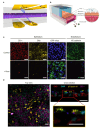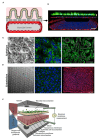Biological Barrier Models-on-Chips: A Novel Tool for Disease Research and Drug Discovery
- PMID: 40558420
- PMCID: PMC12190961
- DOI: 10.3390/bios15060338
Biological Barrier Models-on-Chips: A Novel Tool for Disease Research and Drug Discovery
Abstract
The development of alternatives to animal models and traditional cell cultures has led to the emergence of organ-on-chip (OoC) systems, which replicate organ functions under both physiological and pathological conditions. These microfluidic platforms simulate key tissue interfaces-such as tissue-air, tissue-liquid, and tissue-tissue interactions-while incorporating biomechanical stimuli to closely resemble in vivo environments. This makes OoC systems particularly suitable for modeling biological barriers such as the skin, the placenta, and the blood-brain barrier, which play essential roles in maintaining homeostasis. This review explores various biological barrier models that can be replicated using the OoC technology, discussing the integration of induced pluripotent stem cells (iPSCs) to advance personalized medicine. Additionally, we examine the methods for assessing barrier formation, including real-time monitoring through integrated sensors, and discuss the advantages and challenges associated with these technologies. The potential of OoC systems in disease modeling, drug discovery, and personalized therapeutic strategies is also highlighted.
Keywords: biological barrier; biosensors; microfluidic platforms; organ-on-chip; personalized medicine.
Conflict of interest statement
The authors declare that they have no known competing financial interests or personal relationships that could have appeared to influence the work reported in this paper.
Figures











Similar articles
-
A Comprehensive Review of Organ-on-a-Chip Technology and Its Applications.Biosensors (Basel). 2024 May 1;14(5):225. doi: 10.3390/bios14050225. Biosensors (Basel). 2024. PMID: 38785699 Free PMC article. Review.
-
Signs and symptoms to determine if a patient presenting in primary care or hospital outpatient settings has COVID-19.Cochrane Database Syst Rev. 2022 May 20;5(5):CD013665. doi: 10.1002/14651858.CD013665.pub3. Cochrane Database Syst Rev. 2022. PMID: 35593186 Free PMC article.
-
Advancements in Microfluidic Organ-on-a-chip for Oral Medicine.Int Dent J. 2025 Jul 30;75(5):100925. doi: 10.1016/j.identj.2025.100925. Online ahead of print. Int Dent J. 2025. PMID: 40743817 Free PMC article. Review.
-
Acceptability of 'as needed' biologic therapy in psoriasis: insights from a multistakeholder mixed-methods study.Br J Dermatol. 2024 Jul 16;191(2):243-251. doi: 10.1093/bjd/ljae068. Br J Dermatol. 2024. PMID: 38366988
-
Systemic pharmacological treatments for chronic plaque psoriasis: a network meta-analysis.Cochrane Database Syst Rev. 2021 Apr 19;4(4):CD011535. doi: 10.1002/14651858.CD011535.pub4. Cochrane Database Syst Rev. 2021. Update in: Cochrane Database Syst Rev. 2022 May 23;5:CD011535. doi: 10.1002/14651858.CD011535.pub5. PMID: 33871055 Free PMC article. Updated.
References
-
- Kulkarni M.B., Reed M.S., Jiang S.D., Cao X., Hasan T., Doyley M.M., Pogue B.W. Prototype dual-channel fluorescence/transmission optical tomography system for quantification of capillary permeability and porphyrin production; Proceedings of the SPIE BiOS; San Francisco, CA, USA. 12 March 2024; - DOI
Publication types
MeSH terms
LinkOut - more resources
Full Text Sources

